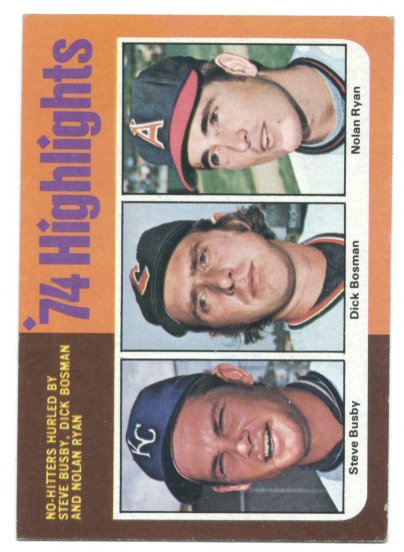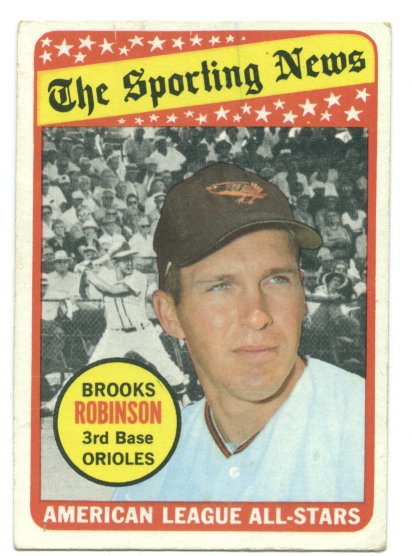

One of my observations is traders are often confused when it comes to condition, especially concerning vintage cards. To be honest, I am also not always that comfortable myself. I know what is good, and I know what is not so good, but assigning an actual grade can be tough. My idea of EX and your idea of EX may be totally different.
This is my attempt to bridge any misunderstandings as well as help out other collectors. I have taken the definitions from Beckett (as I understand them), found examples from my collection and created this guide. The highest grade I started with is NM (near mint). I figure the differences between any grade higher than that is best left to the folks at PSA and other grading companies.
 |
Near Mint (NM) - Centering 65/35 or better. In addition one of the following minor flaws is allowed: a slight touch of wear on two or three corners, slightly rough edges, a few noticeable print spots, color or focus imperfections. My Comments - This is one of my nicer 1975 Topps. There is a noticeable print spot just below center and along the right edge. The corners are excellent, but if you look real close, they aren't perfect. I would be a very happy man if all my 1975s looked like this one. If a cards qualifies as near mint except for the centering, I think it is fair to call a card this as long as you add a qualifier. For example, NRMT (OC). But, if you are someone who trades BV for BV, you have to discount the card when assessing value. |
 |
Excellent- Mint (EXMT) - Centering no worse than 70/30. No more than two of the following flaws are allowed: two or three fuzzy corners, slightly rough edges, very minor discoloration, noticeable print spots, color or focus imperfections. My Comments - I think this is also a pretty nice card, but with a three fuzzy corners and a rough edge in the lower right, I believe this card qualifies as EXMT. The centering is very good and could be worse and still be EXMT. I thought about finding other examples with some of the other listed flaws, and may eventually do that. For now, these three guys will serve as my benchmark. |
 |
Excellent (EX) - Centering no worse than 75/25 with four fuzzy corners (a touch of notching or minor ding is allowed). May also have rough edges, minor border discoloration and noticeable print spots, color or focus imperfections. My Comments - This Brooks has definitely seen better days. One of the things that bugs me about Beckett's grades is the names are deceptive. This is considered "excellent" when in fact, it is not so good. The centering is close to the 75/25 limit. Calculating centering is not my favorite thing. I compare the edges. In this case, the top edge is about half the width of the bottom edge. Some quick math gets me 33/66. Not exact, but close enough to make me comfortable.
|
 |
Very Good (VG) - Handled, but not abused. Centering 80/20 or better. Slightly rounded corners with slight layering, slight notching or noticeable chipping on edges, moderate border discoloration, some gloss lost on surface, very minor scuffing. May have a hair line crease. My Comments - This is the highest grade allowing a crease, albeit a very minor one. If I have a card with a minor crease, but otherwise would be a higher grade, I still call it VG. A lot of collectors are willing to forgive many things, but not creases. I believe calling a card with a minor crease any higher than VG is misleading. This is my only vintage Mays. Willie didn't age as well as a lot of other people. The corners are a bit rougher than the Brooks and there is a slight crease on the right edge near Willie's ear.
|
 |
Good (G), Fair (F), Poor (P) - Well-worn
or abused. Badly rounded and layered corners, scuffing, no original
gloss, major border discoloration, and serious creases.
My Comments - When a card gets to be bad enough, it gets hard for me to even care enough to decide the difference between good, fair and poor. I prefer simply call these cards "beaters" or "set fillers". This is my favorite "beater". I have even thought about having it graded. I am ashamed to admit I am the original owner of this card. What can I say? I was only seven. |
Pluses and Minuses
I am sure you have seen grades like EXMT+ or EX-. The pluses and
minuses are used when a card is in between grades. For example, if you
think a card is a very weak EXMT, but certainly better than EX, call it EXMT-.
My Final Thoughts
I would love to hear feedback from other collectors. Do you thing I am
under or over grading or am I right on? The more collectors I hear from,
the better my guide. I can be reached at mark@wing.cc.